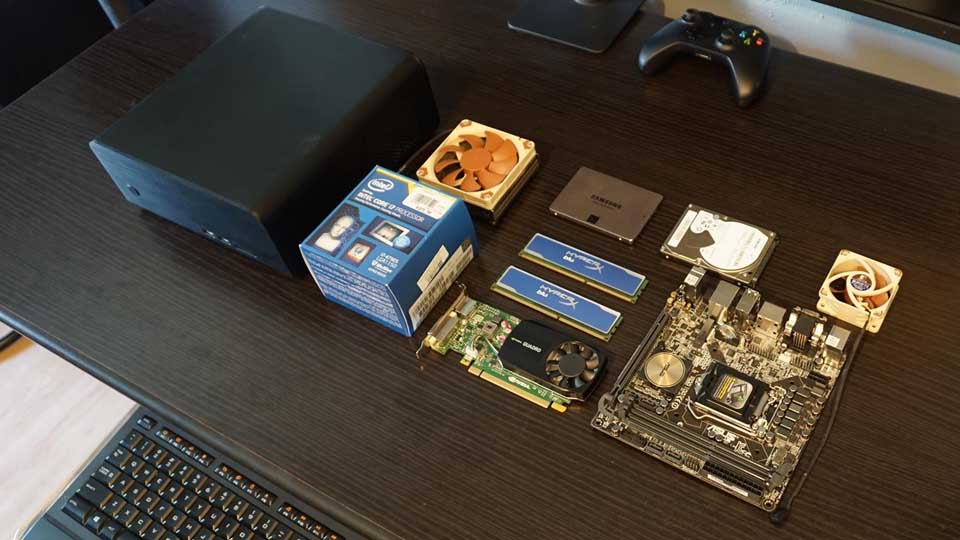I have always had an infatuation with small form factor PC’s. I feel like there is no reason a PC has to be a gigantic, ugly, loud and immobile. It took me quite a bit of time and research to figure out the type of system I wanted to build. The key to doing a build like this, is finding the proper balance between power and size. If you are a hardcore gamer chasing high FPS, then a Mini-ITX build in a HTPC case is not going to work for you. Take your needs into account, then select your components.
Why I Decided To Make This Build
The components most responsible for large case size are the power supply and GPU. Power supplies, even SFX units are fairly large components. They also tend to be a consistent source of noise. I had learned a little about Pico PSU’s, but I always associated them with really low power Mini-ITX or NUC systems. After doing some research I found the combo of a 192W external power brick with a 160W-200W Pico PSU. This turned out to be the perfect set up for the components I was trying to run.
I must issue a warning to anyone thinking of doing a build like this. You really have to determine your systems power draw ahead of time. You do not want to overload or stress the Pico PSU. That is why I went with the i7-4790S instead of the i7-4790, or i7-4790K. Its 65W TDP helps keep the power draw in the range I need it to be. I also chose the Quadro K1200 for the same reasons, in addition to it being the most powerful GPU that could actually fit in the case. Check out the videos below if you want to learn more. Part one covers the initial build, while part two is all about the upgrades.
Part List
Intel Core i7-4790SFrom $289.00
Noctua NH-L9iFrom $39.95
Kingston HyperX RAM 2x8gbFrom $44.19
Asus H97I-PLUS MotherboardFrom $99.00
PNY NVIDIA Quadro K620From $160.00
Wesena ITX-5BFrom $90.00
Pico 160-XT PSUFrom $44.50
192W Power BrickFrom $49.95
PC Part Picker List
Part 2: Upgrades
Upgrade Part List
Samsung 850 EVO M.2From $69.94
Samsung 850 EVO SATAFrom $73.49
Nvidia Quadro K1200From $267.20
16GB EVGA DDR3 RAMFrom $80.00
Noctua NF-A8 FLXFrom $15.93
Dell U3415W MonitorFrom $742.76
Check back to this page periodically as I will be posting the ongoing upgrades and additions here. Next up I will be either building or buying a new case. Stay tuned.



Is that case a Streacom F7C? (http://www.streacom.com/products/f7c-chassis/)
I have a very similar build. How does your computer fare temperature wise? About how many watts does it draw under load?
The Case is actually the Wesena ITX-5B, the Streacom F7C is almost identical. The main difference is that the Wesena doesn’t have the slim optical disk slot. Here is a link to the site I purchased mine from (http://www.shop.perfecthometheater.com/HTPC-ITX5-Silver-Mini-HTPC-aluminum-chassis-HTPC-ITX5-S.htm).
They don’t appear to have the black version anymore, but if you search around the internet you should be able to find one. What do you run in your system?
Here’s my build:
Chassis: F7C Evo (Silver) http://www.streacom.com/products/f7c-evo-chassis/
Motherboard: GIGABYTE GA-Z97N-WIFI http://www.gigabyte.com/products/product-page.aspx?pid=4993
CPU: Intel i7 4770T http://ark.intel.com/products/75125/Intel-Core-i7-4770T-Processor-8M-Cache-up-to-3_70-GHz
RAM: 16GB Crucial Ballistix Sport LP http://www.crucial.com/usa/en/bls2k8g3d1609es2lx0
Power Supply: Streacom Nano150 http://www.streacom.com/products/nano150-psu/
Cooler: Akasa AK-CCE-7106HP http://www.akasa.com.tw/update.php?tpl=product/cpu.product.tpl&type=CPU%20coolers&type_sub=Low%20Profile&model=AK-CCE-7106HP
HDD: 1 TB Seagate Barracuda 7200 RPM http://www.seagate.com/internal-hard-drives/desktop-hard-drives/desktop-hdd/?sku=ST1000DM003
GPU: NVIDIA Quadro K1200 https://www.pny.com/nvidia-quadro-k1200-displayport
Slot load Blu ray drive
I recently added the K1200 replacing an NVS 315. This increased the overall power usage, but it still idles around 40W. In the future, I’d like to replace the Akasa cooler with a Noctua NH-L9i, and the Seagate with a Samsung 850 EVO and a 2.5 HDD.
Awesome system man, ours are very similar. How do you like it so far?
Hello Jay. Well, I did replace the HDD with an 850 EVO and the Akasa with the Noctua. It runs great for me, albeit a little hot under heavy loads. The CPU tends to throttle itself when running benchmarks, but less so now with the Noctua cooler. The GPU definitely gets hot and has to throttle when running Furmark, but my normal use won’t push it that hard. I really enjoy being able to slip my computer, mouse, and keyboard (Apple MB869LL/A) into my backpack for travel. I need a tiny computer for now, but if I ever have more room, I might try a larger case for better airflow.
Hello,
Thanks for posting the m-ITX build. As a design exercise, it is a point of inspiration for me… I want to build a small but powerful workstation, and have also spent several hours researching various configurations and components.
I noticd that the build guide was not very specific as to:
* exactly which applications would be supported
* the setting in which the device would be placed while in use
* how the device would be transported from place to place
* The available connectiviy at those places (Wifi, bluetooth, Ethernet, etc.)
Perhaps these were left unspecified so that the build guide could interest more people…? Without knowing the above specs it is difficult to evaluate the effectiveness of the Wesena case build-out.
If I may share my journey thus far…
What I learned through research, though, is that:
* The smaller the device, the more portable it is and therefore more likely to include WiFi and Bluetooth connectivity.
* The small PC space is very crowed with highly optimized solutions at attractive prices.
* Some packaging is so optimized, it’s as though the vendor took the electrical hardware footprint and injection molded a case around it. Some run too hot, but some do not.
* Wesena cases seem difficult to find now in 2016. For example, they have a ITX7 model with optical disk drive… just hard to find a seller.
Conclusion: When the application is adequately specified, the vendor has the advantage (due to scale of manufacturing / miniaturization) over us individual tinkerers, unfortunately. Some examples of current mini PC vendors / product lines are:
1) Gigabyte / Brix, several models (Amazon or newegg)
2) Zotac / Zbox, several models (Amazon or newegg)
3) Shuttle / SZ87R6 and SH87R6 (Amazon or newegg)
4) Cenovo / Dual OS Mini PC (banggood.com)
5) [Several vendors] / tiny, mini PCs VESA-mount to the back of a monitor for DIY all-in-one for medical, internet cafe, etc. where space is very limited
6) M350 m-ITX case for picoPSU solution claims to be the smallest m-ITX mobo (Amazon)
The current front-runner for my needs (engineering workstation running Solidworks, mostly stationary location) is the Shuttle SZ87R6.
* The vendor invened the mITX FF motherboard… has been doing this for about 30 years
* Case is approx 8″ x 8″ x 13″… I can find no smaller cased PC that has same or similar functionality Note: Amazon’s size specs are incorrect)
* Includes internal 500W PS, 80 bronze
* Mobo has 32 GB RAM capacity, overcoming the main reason to switch up to ATX boards
* Does not have M.2 slot, but has PCIe slots which some reviewers say are faster, and note that some M.2 SSDs get warm enough to throttle back their speed, too.
* Has WiFi option (though I would use Intel’s Wifi PCIe module and two antennae)
* Allows full-length video card (one double or two single wides)
* Has slots for Optical disk and 3.5 HD with external access
* Has integrated watercoolded CPU slot with motherboard
* Has USB 3.0 slots on the front panel
* Does not have filter screens, but these could be added
* The internals run with moderate heating under full processing load (heat pipes are very effective).
* Amazon reviews are mixed; newegg reviews are better… which reflects IMO that newegg users are technically more savvy on average
These Shuttle PCs are designed to run 24/7 for “video walls” – several monitors joined edge-to-edge. The PC design just happens to coincide with a workstation need in which the user cannot justify the expense of Xeon CPU(s) and ECC memory, 3-year onsite service contracts that would put the price closer to $3000. I figure a Shuttle workstation with i7 4790K and Quadro 2200 with 32 GB RAM for under $1500 – practically a steal, esp. in SFF w/o overheating.
-Regards,
Bruce
[…] display is the Dell U3415W 34″ Ultrawide. To the left you will find my custom mini-ITX PC. I did a full build log on the PC and review on the […]
Hello Jay,
I really like the setup. I’m planning to build something like this but I want to use it as a plex server.
In that case I can do without the graphics card isn’t it?
Regards,
René
You should be fine with the integrated graphics on a modern CPU yes.
[…] to your own personal needs. I have always loved small but powerful machines. You can check out my two older builds if you want to see what I […]